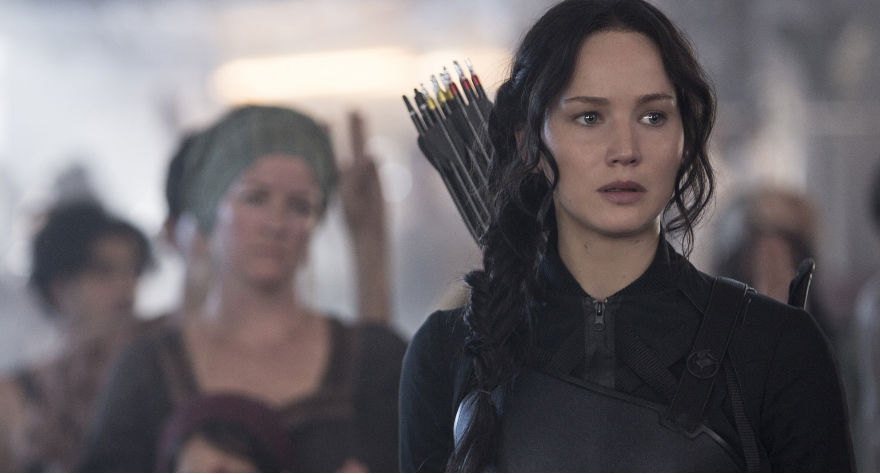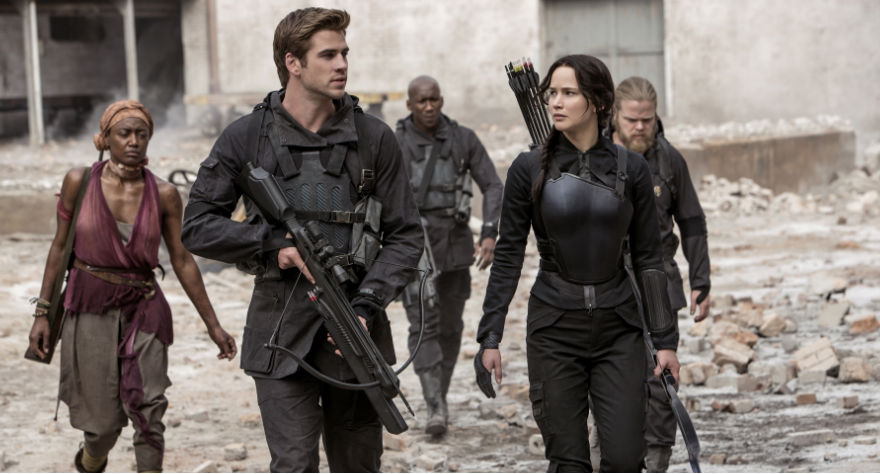
More somber and less engaging than its predecessors, Mockingjay sorely lacks purpose.

More somber and less engaging than its predecessors, Mockingjay sorely lacks purpose.
Following the money-doubling strategy that maximized the lucrativeness of the Harry Potter and Twilight franchises, the third book in Suzanne Collins’ dystopian-epic Hunger Games series has been split into two movies, the first of which, The Hunger Games: Mockingjay – Part 1, hits theaters today. Halving the franchise’s third act is a smart business move no doubt, but there’s an artistic compromise involved that Mockingjay‘s shortcomings can largely be attributed to. This doesn’t feel like a fully-formed movie; it feels like an episode, a placeholder, a transient experience that’ll get you excited for the series’ explosive conclusion, but doesn’t offer much sustenance on its own to encourage revisiting (unlike its excellent, re-watchable predecessor, Catching Fire). The movie’s abrupt, randomly-placed ending is frustrating and off-putting because, well, it happens in the middle of the book. It’s not an ending at all, really. But hey, in the big-budget landscape of Hollywood, where two tickets are better than one, them’s the breaks.
Mockingjay is the darkest entry in the series, in more ways than one. Gone this time around are the glitz, pageantry, and blood-soaked spectacle of the games themselves, with fierce rabble-rouser Katniss Everdeen’s defiance of the tyrannical President Snow instead taking center stage. Katniss has been positioned (whether she likes it or not) as the symbol for the brewing insurgency sparked by her survival of two Hunger Games in a row, and throughout the film we follow her as she grows into her new role as “The Mockingjay”, the rebellion’s goddess of war.
The film largely takes place within the bowels of District 13, a forgotten, underground compound that looks like a dreary doomsday silo and now acts as headquarters for the rebel forces. Running the show down below are the benevolent President Coin (Julianne Moore, a series newbie) and Capitol turncoat Plutarch (Philip Seymour Hoffman), who together use Katniss and her image to stoke the flames of the revolution. Also roaming the halls of District 13 is former Hunger Games fashion consultant Effie (Elizabeth Banks), who misses her giant wigs and is none too pleased by the drab jumpsuits she’s now forced to wear.

J-Law’s casting as the durable, tormented Katniss continues to be the franchise’s greatest boon. She has a knack for making scenes that, while perhaps silly on the page, come off as totally convincing on screen. In a scene that serves as both an exhibition of her acting skills and a meta examination of the franchise’s mass appeal, Katniss, dressed in warrior-queen armor and standing in front of a green screen, awkwardly postures and regurgitates cheesy lines for a rebel propaganda video. It’s all good for a laugh, but it also succinctly expresses how unready she is to be a revolutionary symbol, as well as how distressed and divided she is on the inside. Also affecting are recurring scenes in which a watery-eyed Katniss is tortured by broadcasted videos of baker boy Peeta Mellark (Josh Hutcherson), who’s being held captive by President Snow (again played by the naturally dastardly-looking Donald Sutherland) and is looking more sickly with each televised appearance.
Moments like these–in which the characters act in front of a camera to further a political agenda, echoing the duplicitous nature of politics in our own society–are a trademark of the series. The device is growing a little stale, but the message still rings true. The key theme here, though, is liberation from oppression. Peppered throughout the film are sequences of citizens fighting back against Capitol forces, as well as images of mass slaughter (a rebel raid on a Capitol dam is breathtaking). The amount of action in Mockingjay is considerably less than its predecessors, as the focus here is more on the larger costs of war rather than intimate acts of violence. (That isn’t to say the film isn’t violent, though: a multi-district execution scene’s lurid presentation is particularly startling.) The stakes feel high, and that’s a good thing.
What isn’t so good, however, are the film’s momentum-less pacing and shapeless plot. The story never finds its purpose, because its purpose lies in another movie, which we won’t see until next year. The climax we’re given around the series’ most insipid sub-plot: the love triangle between Katniss, Peeta, and Gale (Liam Hemsworth). The thing that appeals to me most about Katniss as a character (besides her being a legitimately dangerous badass) is that, unlike most other Hollywood heroines, her existence isn’t defined by her romantic life. In fact, she barely has one! She’s more than compelling enough on her own, and to be honest, it’s hard to think of more uninteresting characters than Gale and Peeta, whose personalities are virtually interchangeable. They’re both heroic, they both really love Katniss. One’s tall, one’s small. Blah, blah, blah. Who needs ’em? To be fair, the the story isn’t so fascinated with the boys. But in this film more than the others, I questioned whether or not I care about them at all.
There’s a lot of talking in Mockingjay: talking in rooms, talking on rubble, talking at TV screens. No one is given much to do besides skulk and strategize in their drab living quarters and war rooms. It’s obvious that underneath all of the motivational speeches and propaganda videos, what this movie is really meant to do is bide time until Part 2 hits next year. I’m willing to bet that, in the grand scheme of things, Mockingjay won’t be viewed as such a trudge of a movie. I’m hoping Part 2 blows us away and gives Part 1 some much-needed context and payoff. I just wish I didn’t have to wait so long to gulp down the chaser for this bland, bitter drink of a film.